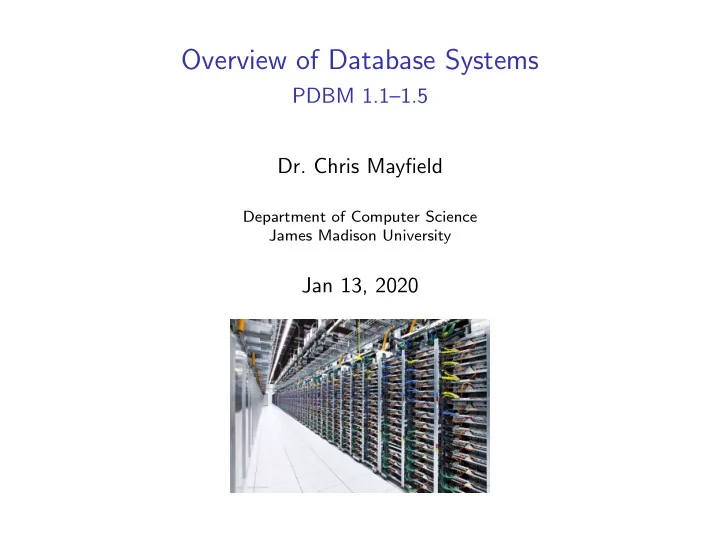

Overview of Database Systems PDBM 1.1–1.5 Dr. Chris Mayfield Department of Computer Science James Madison University Jan 13, 2020
Ice breaker Discuss in small groups: 1. What is a database? 2. What are common examples? 3. Why should we study databases? Please also complete the survey Jan 13, 2020 Overview of Database Systems 2 of 19
What is a database? In essence: ◮ a collection of information, that ◮ exists over a long period of time Managed by a DBMS 1. Support storage of large amounts 2. Allow users to specify a schema 3. Give users ability to query data 4. Enable durability and recovery 5. Control concurrent access to data Jan 13, 2020 Overview of Database Systems 3 of 19
What are common examples? And many others! Jan 13, 2020 Overview of Database Systems 4 of 19
Why study databases? Academic ◮ Databases involve many aspects of computer science ◮ Well-established and very active area of research ◮ Three Turing awards in databases (at least) Business ◮ Everybody needs databases → lots of money to be made Programmer ◮ Many applications involve using and accessing databases Student ◮ Databases are so cool! ◮ Google/etc will hire me! ◮ Need those last 3 credits! Jan 13, 2020 Overview of Database Systems 5 of 19
Database management systems Commercial Open Source Jan 13, 2020 Overview of Database Systems 6 of 19
Why use a DBMS? Manage ◮ Store and process large amounts of data Organize ◮ Give structure (i.e., schema) to the data Query ◮ Extract interesting/relevant information Data Independence “The ability to change the organization of the database itself without changing the application software.” (Brookshear 12/e) Jan 13, 2020 Overview of Database Systems 7 of 19
Features of a DBMS Support massive amounts of data ◮ Far too big for main memory (GB / TB / PB) ◮ “Recent” trend: databases run on single computers Persistent storage ◮ Applications update, query, manipulate data ◮ Data continues to live long after apps finish Efficient and convenient access ◮ Do not search entire database to answer a query ◮ Tools for users to create and query the data Concurrent, and atomic access ◮ Allow multiple users to access database simultaneously ◮ Provide some guarantee of reliability against failures Jan 13, 2020 Overview of Database Systems 8 of 19
Transaction processing Database operations are grouped into transactions Transactions should meet ACID requirements: ◮ Atomicity: All-or-nothing execution of transactions. ◮ Consistency: Should NOT violate DB’s constraints. ◮ If it does, it needs to be rolled back ◮ Isolation: Each transaction must appear to be executed as if no other transaction is executing at the same time. ◮ Changes become visible only after committed ◮ Durability: Any change a transaction makes to the database should persist and not be lost. Jan 13, 2020 Overview of Database Systems 9 of 19
Jan 13, 2020 Overview of Database Systems 10 of 19
A brief history of DBMSs The earliest DBMSs (1960s) evolved from file systems ◮ Navigational and hierarchical ◮ User programmed queries by walking from node to node Relational DBMS (1970s to now) ◮ View database in terms of relations or tables ◮ High-level query and definition languages such as SQL Object-oriented DBMS (1980s) ◮ Inspired by object-oriented languages ◮ Object-relational DBMSs “New” types of data: ◮ Semi-structured data (XML, JSON) ◮ Data streams (continuous queries) Jan 13, 2020 Overview of Database Systems 11 of 19
Two great overview papers What Goes Around Comes Around PDF Link Anatomy of a Database System PDF Link by Michael Stonebraker and Joseph M. Hellerstein Jan 13, 2020 Overview of Database Systems 12 of 19
Today’s (yesterday’s?) databases RDBMS = Relational DBMS ◮ The relational model uses relations to structure data ◮ Separates logical view (externals) from physical view (internals) ClassList relation: Student Course Grade Hermione Grainger Potions A- Draco Malfoy Potions B Harry Potter Potions A Ron Weasley Potions C Structured query language (SQL) for accessing/modifying data: SELECT student FROM roster WHERE grade >= ✬ B ✬ ; Jan 13, 2020 Overview of Database Systems 13 of 19
SQL vs Python Declarative programming: SELECT student FROM roster WHERE grade >= ✬ B ✬ ; Imperative programming: import csv def main (): data = open("roster.csv") data = csv.reader(data) for row in data: student = row [4] grade = row [7] if grade >= "B": print(student) if __name__ == "__main__": main () Jan 13, 2020 Overview of Database Systems 14 of 19
Data storage https://raima.com/database-system-vs-file-system/ Jan 13, 2020 Overview of Database Systems 15 of 19
Administrivia Welcome back!
Course logistics Course home page: http://w3.cs.jmu.edu/mayfiecs/cs374 Find Q&A on Piazza: http://piazza.com Homework and grades: https://canvas.jmu.edu Your TODO List ◮ Read the Syllabus before the next class ◮ Be sure to read 1.1–1.5 in the textbook ◮ HW1 will be posted soon . . . start early! ◮ Need to form project groups next week Jan 13, 2020 Overview of Database Systems 17 of 19
Grade requirements Assignments 20% ◮ Written problems ◮ SQL programming Group Project 30% ◮ Use lots of public data ◮ Work in groups of four Midterm #1 25% Midterm #2 25% Jan 13, 2020 Overview of Database Systems 18 of 19
Tips for success Come to class prepared ◮ Read the textbook — all of it! Start homework early ◮ Something due each week Stop by office hours ◮ Mon/Wed 1:15–2:45 PM ◮ Other times by appointment HAVE FUN! Jan 13, 2020 Overview of Database Systems 19 of 19
Recommend
More recommend